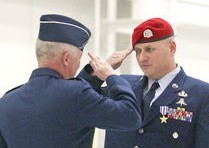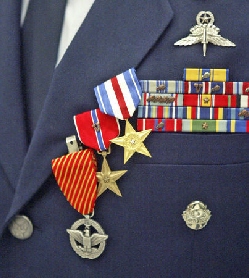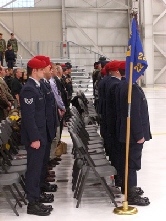| A three-star general had
just pinned three medals to Scott Innis’ left lapel, but the
technical sergeant avoided talking about himself. |
 |
The 16-year veteran of the Air Force said he was happy
his family could attend the ceremony and the honor bestowed on his
unit, the 22nd Special Tactics Squadron.
But, someone asked Innis, what did it mean to him
personally?
“I’m happy for my unit,”
he replied. “I like that I got the promotion points. And I
think it’s 10 percent on my retirement, and that’s
kind of cool.”
|
Innis might have deflected the personal glory, but make
no mistake – plenty of attention was focused on him.
|
 |
A Silver Star has a way of doing that.
Innis received the nation’s third-highest award for valor at
a ceremony in a hanger at McChord Air Force Base for calling in aerial
strikes from an exposed position during an attack in Afghanistan last
year. He also received a Bronze Star and the Air Force Combat Action
Medal for his duty while working as a joint terminal attack controller
attached with an Army Special Forces unit.
Thirteen other airman received medals at the ceremony, but Air
Force officials asked the news media not to identify all but one for
security reasons. Ten Bronze Stars, two Purple Hearts and 12 Air Force
Combat Action Medals were awarded.
Lt. Gen. Donald C. Wurster, the commander of the Air Force
Special Operations Command, was on hand to award the medals. He
compared the elite airmen to warriors from the Old Testament.
“A dozen Special Forces soldiers with a Combat
Controller is an extremely lethal force when combined with
airpower,” he said after the ceremony. “We showed
it in the early days of Afghanistan, and we continue to show it
today.”
 |
Innis’ medal
stems from his actions on March 28, 2006, when Innis and other members
of the Army Special Forces detachment came under fire of
rocket-propelled grenades, mortar rounds, heavy machine-gun and
small-arms fire from three directions. Despite the danger, Innis scaled
a ladder to an observation platform stationed at the center of their
firebase. The platform was the only structure visible outside the
perimeter and received the bulk of enemy fire.
From that platform, he
called in and helped guide aerial counterattacks. He remained on the
platform despite several close calls during the 24-hour battle and also
coordinated to get injured coalition soldiers evacuated. The airpower
he directed led to the death or injury of more than 100 Taliban
insurgents.
“He’s
a quiet professional,” said Lt. Col. Jeffrey F. Staha, the
commander of the 22nd Special Tactics Squadron.
“He’s one of the guys I turn to handle tough
missions.”
Tech. Sgt.
Jason Dryer received a Bronze Star and a Purple Heart. In April,
insurgents ambushed his unit in Afghanistan with rocket-propelled
grenades
|
and small-arms fire. Dryer fought through the ambush and called in an
airstrike by an AC-130 gunship. He also called in strikes to quash
second and third waves of the ambush.
He later injured his knee and shoulder when an
improvised-explosive device detonated near his vehicle in Afghanistan.
“I remember turning back to my friend and saying,
‘I can’t wait for this to be over,’
” he said. “I turned back and don’t
remember anything else. I woke up in my friend’s arms with
all my clothes were cut off me and all bloody.”
He went to Kandahar for treatment and returned to his unit
downrange about 10 days later.
Dryer said he’ll continue training and awaits his
next assignment. Wurster had a message for him.
“I told him I didn’t want to give him
another Purple Heart,” Wurster said, “so
don’t earn one.”